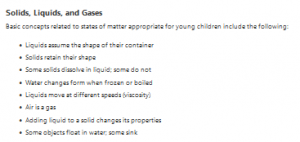Solids, Liquids, and Gases
Basic concepts related to states of matter appropriate for young children include the following:
- Liquids assume the shape of their container
- Solids retain their shape
- Some solids dissolve in liquid; some do not
- Water changes form when frozen or boiled
- Liquids move at different speeds (viscosity)
- Air is a gas
- Adding liquid to a solid changes its properties
- Some objects float in water; some sink
Corresponding terminology includes the words liquid, solid, gas, volume, dissolve, and solution. Different liquids (milk, juice, syrup, water), cornstarch, bubble wands, glycerin, dish soap, straws, blender, and empty soda bottles are all materials that can be kept on hand for explorations with solids, liquids, and gases. These activities should encourage children to do things like dropping marbles into different fluids to see how long they take to sink to the bottom or observing ice cubes as they melt in water.
Teachers can enlist children in mixing equal parts cornstarch and water, which confounds them as it exhibits properties of both solids and liquids at the same time. Making bubble solution with glycerin and dishwashing liquid and then blowing bubbles with wands fascinates them, and the teacher can help them to understand that the air inside the bubble is trapped by a liquid “shell.” Children can also blow bubbles through a straw into milk, water, and syrup or pour these kinds of liquids back and forth to explore viscosity.
Making fruit smoothies demonstrates the principle of a suspension. Children can classify and label objects in the classroom as liquids or solids or have a liquid lunch, and they will certainly spend a great deal of time at the water table exploring the concepts of sinking and floating.
Place Your Order Here!
